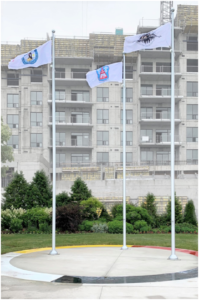City of Sarnia updates waterfront flag court with local First Nation representation

By Colin Graf
SARNIA— The flags of the three First Nations in the area surrounding the southwestern Ontario city of Sarnia are now flying proudly and prominently beside the waterfront trail along the St. Clair River walked by many each day.
The flags from Aamjiwnaang, Chippewas of Kettle & Stony Point, and Walpole Island (Bkejwanong) First Nations together represent the signatories to Crown Treaty Number 29, known as the Huron Tract Treaty.
The flag plaza is a project organized by Sarnia’s United Nations Declaration of Rights of Indigenous Peoples (UNDRIP) Committee, and installed by municipal staff with approval from City Council, explains committee Chair Candace Young.
Young, a member of Kettle & Stony Point and Lambton College professor, said the committee decided the installation was needed because “we want to acknowledge these communities. To show the city’s relationship to these communities is important.” The idea came to the forefront of ideas the committee was considering after members remarked that Sarnia’s original waterfront flag court that flies the Canadian and provincial flags had no First Nation representation.
The outer ring of the flag plaza features the Medicine Wheel that embodies the Four Directions, as well as Father Sky, Mother Earth, and Spirit Tree; all of which symbolize dimensions of health and the cycles of life. This portion was as important as the flags, Young says, as the Medicine Wheel “represents that balance between body, mind, spirit, and emotion.”
In planning the plaza, committee members met with Elders from all three nations who were consulted in order to create a “culture card” and a plaque with information for the wider public about Anishinabek culture, local Indigenous communities and people, the Huron Tract Treaty, Indigenous culture today, language, and the Anishinabe Creation Story, Young explains. The text for the card, which will be a paper handout, and the plaque, is in the final stages of editing.
The culture card and plaque are meant as educational tools, as the UNDRIP committee wants to ensure that “education is at the forefront” of their work. The advisory body was established by City Council in 2017 to help develop a plan to implement the United Nation Declaration in the city. The committee, with members from the business and not-for-profit sector, along with city councillors and First Nations and friendship centre representatives, has drafted the city’s land acknowledgement that is read before Council meetings, and is working on other projects including a possible community summit meeting to help the settler public learn more about their First Nation neighbours, and also the issue of racially-targetted street names.
Young says conducting research for the plaza was enlightening for her as she didn’t know much about Treaty 29 beforehand. Learning the story led her to discover the actual intent behind the treaty was different than many Canadians might expect.
“I don’t think many people realize that the spirit and intention of the treaty was to share the land, not surrender it,” she explains.
Landscaping using native plants sourced from the Aamjiwnaang greenhouse, will be installed, but probably not until next spring, says Young. An opening ceremony has been postponed until Sept. due to COVID-19 pandemic regulations. She hopes to hold it in conjunction with Orange Shirt Day that month.


